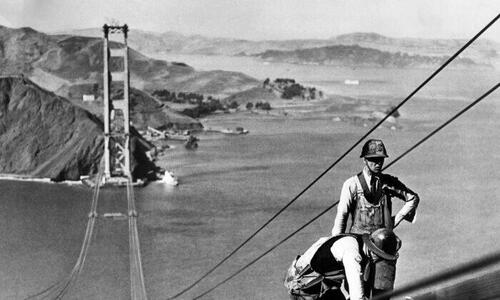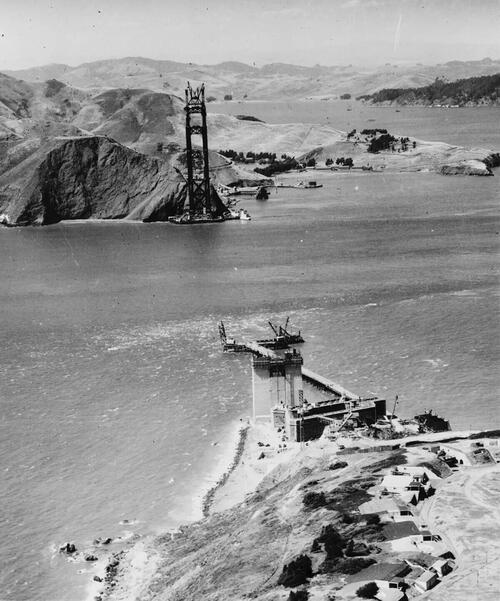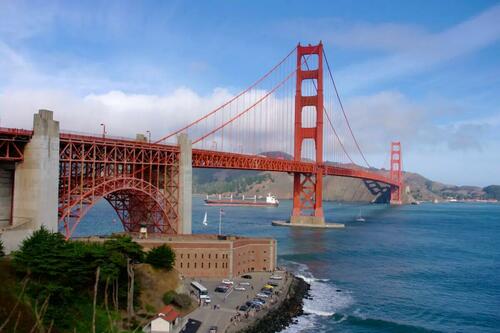How The ‘Bridge That Couldn’t Be Built’ Was Built
Authored by Dustin Bass via The Epoch Times (emphasis ours),
When John A. Roebling completed the Covington-Cincinnati Bridge in 1866, it was the longest suspension bridge in the world. Shortly after completing the bridge, which crossed the Ohio River, he was hired to design the Brooklyn Bridge. This bridge would surpass the length of the Covington-Cincinnati Bridge by a third. Roebling, unfortunately, would die before he could witness the construction of the New York City-based structure; but his son Washington and daughter-in-law Emily would complete the project in his stead.
Roebling’s influence was arguably most strongly felt by his immediate family and his legacy most attached to the Brooklyn Bridge. But approximately 25 years after his death, a young engineer would incidentally be influenced by Roebling and would directly extend the suspension bridge builder’s legacy to the other side of the country in San Francisco.
Before Joseph Strauss graduated from the University of Cincinnati in 1892, he found himself in the hospital recovering from an illness. The 5-foot-3-inch class president and class poet had been placed in a hospital room with a view that would change the course of his life. Through the window, he could see the Covington-Cincinnati Bridge. The structure inspired him to pursue a career in bridge design.
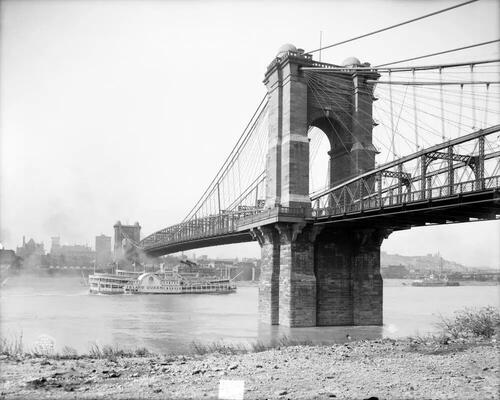
During his graduation ceremony at the university, he professed his goal to build a railroad that would stretch across the Bering Strait. His goals were lofty, if not impossible, but it was this drive that would place him in the position to create “the bridge that couldn’t be built.”
A Bridge Across the Strait
The idea of a bridge that stretched across the Golden Gate Strait had been discussed for decades. It was first broached in 1872 by Charles Crocker, the railroad magnate who had been part of the “Big Four” to found Central Pacific Railroad. (Joshua Norton, the Gold Rush speculator who went bankrupt and then insane, is also credited with making the first calls for the bridge in 1869, though he was hardly taken seriously.)
As the Bay Area population continued to grow exponentially over the final decades of the 19th century, a bridge across the strait seemed imperative. But the problems that faced engineers were many. The Pacific Ocean with its strong tides fed right into the strait, not to mention the consistent wind gusts that swept along the coast, and the city’s famous fog. Additionally, the San Andreas Fault lay seven miles off the city’s coastline, which could initiate devastating earthquakes, as citizens discovered in 1906.
Ten years after the earthquake, the topic of the bridge was again broached in earnest. James H. Wilkins, an editor and publisher of a local newspaper, as well as a former structural engineer, began a campaign to promote the necessity of building the bridge.
“In 1872,” he recalled, “I was present at a session of the Marin supervisors when Charles Crocker explained his plans, among which was a suspension bridge across the Golden Gate. Detailed plans and estimates for such a bridge were actually made by the Central Pacific engineers.”
But that was nearly 50 years prior, so new estimates were needed. Wilkins’s campaign caught the attention of Michael M. O‘Shaughnessy, the San Francisco city engineer. O’Shaughnessy began seeking the opinions of engineers. Their opinions were not positive. The price tag at $100 million was cost-prohibitive.
Sounding the Strait
Interest in the bridge remained, although it waned during World War I, as the country became involved shortly after Wilkins began his campaign. Toward the end of 1918, interest resumed. Richard Welch, a member of San Francisco’s Board of Supervisors, issued a request that Congress authorize a federal survey of the strait: specifically between the Presidio, located on the northern tip of the San Francisco peninsula, and the Marin Peninsula, on the northern side of the strait.
Congress acquiesced to the request, and the USS Natoma, of the United States Coast and Geodetic Survey, conducted soundings of the area by the end of May 1920 and submitted its report.
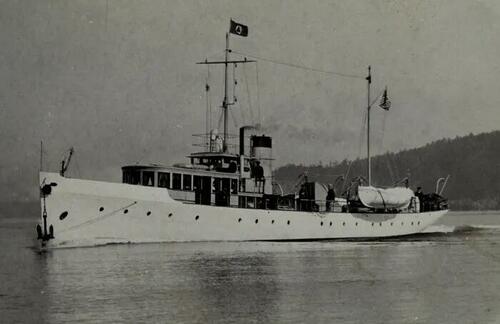
The report was submitted to O’Shaughnessy, who then reached out to three prominent bridge builders: Francis McMath, Gustav Lindenthal, and Strauss. In his letter to them, he wrote, “Everybody says it cannot be done and that it would cost over $100,000,000 if it could be done.”
Lindenthal responded with a quote of $50 million to $60 million. McGrath did not respond. Strauss, after conversing with O’Shaughnessy, suggested it could be done for approximately $25 million.
Strauss, Counties, and the War Dept.
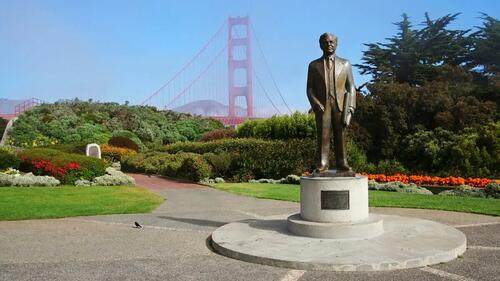
By this time, Strauss had already become one of the country’s prominent bridge builders. He had begun his career as a draftsman for New Jersey Steel and Iron Company, then for Chicago’s Lassig Bridge and Iron Works Company. He worked with then arguably America’s greatest bridge builder, Ralph Modjeski. Strauss, however, wished to pursue the bascule bridge, which are drawbridges. In 1904, he founded Strauss Bascule Bridge Company and would go on to construct approximately 400 bridges.
Considering his reputation, it was apparent Strauss knew something the others didn’t. Strauss was hired, but the process had only just begun, and construction was still more than a decade away.
Entities were created, such as the Association of Bridging the Gate, which encompassed representatives from the surrounding counties. Their objective was to ensure that all counties were in favor of building the bridge and to gain permission from the state legislature to create a legal district, which would manage the entire process of building and maintaining the bridge and roadway. In May of 1923, the state congress passed the Golden Gate Bridge and Highway District Act of California, permitting the Association to create the aforementioned district, which was created in December 1928.
The District was to have control over the project, but the Presidio was a U.S. Army outpost and was therefore under the jurisdiction of the U.S. War Department. In fact, both sides of the proposed locations for the bridge were under the Department’s jurisdiction, and for construction to be conducted, the District would need a federally issued permit. The concerns for the War Department was whether the bridge would hinder navigation and logistics, as well as whether the bridge could possibly become a blockade if it were ever destroyed. On Christmas Eve 1924, Secretary of War John Weeks issued a temporary permit.
The representatives from Del Norte, Marin, San Francisco, Sonoma, and parts of Mendocino and Napa Counties made up the new Golden Gate Bridge and Highway District with Strauss as chief engineer. Strauss was bent on building “the biggest thing of its kind that a man could build,” and, as the preliminary issues fell into place, he would soon get that chance.
Change of Plans
Strauss added Charles Ellis, professor of structural and bridge engineering at the University of Illinois, to his team to update design plans and ensure structural integrity. Eventually, that relationship would sour to the point that Strauss relieved Ellis of his position. Ellis also received no credit from Strauss for his contributions.
Before that relational fallout, however, Ellis played a pivotal role in developing the bridge and was relied upon heavily by Strauss. He, along with Leon Moisseiff, who had designed the Manhattan Bridge, provided reports on their concerns about Strauss’s proposed cantilever-suspension bridge. It seems it may have been as late as the summer of 1929 that Strauss decided to dispense with his cantilever-suspension bridge in favor of a suspension bridge.
It appeared as though the Golden Gate project would soon be underway, but another catastrophe looked to sideline the project. Reminiscent of past decades, like the 1906 Earthquake and World War I, the Stock Market crashed on Oct. 29, 1929, eventually plunging the country into the Great Depression. Permits and plans were one thing, but having the people’s support for such an expensive project was another. The District decided to have the people vote on it.
There had been opposition to the construction of the bridge for varying reasons from the likes of environmentalists and ferry operators, as well as engineers who believed the project unfeasible. The District put the $35 million bond issue before the voters. This bond required locals to use their business properties, farms, and homes as collateral. Despite the great personal risk required, on Nov. 4, 1930, the bond passed overwhelmingly: 145,057 to 46,954.
Mitigating Risks
During this period in major structure building history, there was the assumed risk of one fatality per $1 million. At $35 million, the District could expect approximately 35 job-related deaths. Strauss, however, desired to reverse this trend. Before construction began, he instituted new safety measures and gear, including glare-free goggles and mandatory hard hats, which were made similar to those worn by miners. Additionally, during the later stages of the bridge’s construction, he spent $130,000 to place a large net under the bridge to catch falling workers. In all, this net saved the lives of 19 men, who hailed themselves members of the “Halfway-to-Hell Club.” Eleven men died during the four-year project, 10 of whom died during a single accident when a 5-ton piece of scaffold fell through the net into the water.
With the Great Depression in full swing by the time construction got underway, there was no shortage of men looking to join the major project, especially with its union pay far exceeding what could be found elsewhere. On Dec. 22, 1932, workers began constructing a 1,700-foot access road toward the Marin anchorage of the bridge.
It was during this week in history, on Jan. 5, 1933, that construction began on the suspension bridge, which would famously become known as the Golden Gate Bridge. The first portion of the project was to remove 3.25 million cubic feet of dirt for the bridge’s two anchorages. Not including those anchorages, the bridge would weigh approximately 840 million pounds. Its highest peak above the water would reach 746 feet, and with its famous “International Orange” color, it proved visible even during foggy days. The bridge was suspended by 27,572 wires, altogether long enough to wrap around the globe more than three times. And, reminiscent of his initial Roebling inspiration and his personal determination, Strauss’s bridge held the title of the longest suspension bridge in the world for 27 years after its completion on May 27, 1937.
Tyler Durden Sun, 01/12/2025 – 15:10
Source: https://freedombunker.com/2025/01/12/how-the-bridge-that-couldnt-be-built-was-built/
Anyone can join.
Anyone can contribute.
Anyone can become informed about their world.
"United We Stand" Click Here To Create Your Personal Citizen Journalist Account Today, Be Sure To Invite Your Friends.
Before It’s News® is a community of individuals who report on what’s going on around them, from all around the world. Anyone can join. Anyone can contribute. Anyone can become informed about their world. "United We Stand" Click Here To Create Your Personal Citizen Journalist Account Today, Be Sure To Invite Your Friends.
LION'S MANE PRODUCT
Try Our Lion’s Mane WHOLE MIND Nootropic Blend 60 Capsules
Mushrooms are having a moment. One fabulous fungus in particular, lion’s mane, may help improve memory, depression and anxiety symptoms. They are also an excellent source of nutrients that show promise as a therapy for dementia, and other neurodegenerative diseases. If you’re living with anxiety or depression, you may be curious about all the therapy options out there — including the natural ones.Our Lion’s Mane WHOLE MIND Nootropic Blend has been formulated to utilize the potency of Lion’s mane but also include the benefits of four other Highly Beneficial Mushrooms. Synergistically, they work together to Build your health through improving cognitive function and immunity regardless of your age. Our Nootropic not only improves your Cognitive Function and Activates your Immune System, but it benefits growth of Essential Gut Flora, further enhancing your Vitality.
Our Formula includes: Lion’s Mane Mushrooms which Increase Brain Power through nerve growth, lessen anxiety, reduce depression, and improve concentration. Its an excellent adaptogen, promotes sleep and improves immunity. Shiitake Mushrooms which Fight cancer cells and infectious disease, boost the immune system, promotes brain function, and serves as a source of B vitamins. Maitake Mushrooms which regulate blood sugar levels of diabetics, reduce hypertension and boosts the immune system. Reishi Mushrooms which Fight inflammation, liver disease, fatigue, tumor growth and cancer. They Improve skin disorders and soothes digestive problems, stomach ulcers and leaky gut syndrome. Chaga Mushrooms which have anti-aging effects, boost immune function, improve stamina and athletic performance, even act as a natural aphrodisiac, fighting diabetes and improving liver function. Try Our Lion’s Mane WHOLE MIND Nootropic Blend 60 Capsules Today. Be 100% Satisfied or Receive a Full Money Back Guarantee. Order Yours Today by Following This Link.




